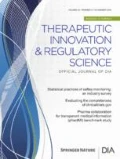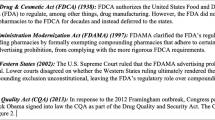Abstract
The term compounding generally refers to the practice of combining, mixing, or altering ingredients of a drug product to create a medication tailored to the needs of an individual patient. Compounding has long been a common activity within the practice of pharmacy. The scope of pharmacy compounding includes the compounding of sterile products, a practice that is especially prevalent within hospitals, home infusion pharmacies, and, more recently, outsourced compounding facilities. Reports of patient morbidity and mortality associated with compounded products have led many over the years, including the US Food and Drug Administration (FDA), to call for more stringent federal oversight of pharmacy compounding to ensure patient safety. A tipping point was reached in 2012 with the emergence of a multistate outbreak of fungal meningitis and other infections in patients who received contaminated steroid injections compounded by the New England Compounding Center in Framingham, Massachusetts. This article describes the history of the practice and regulation of pharmacy compounding, culminating in the passage by Congress of the Compounding Quality Act of 2014.
Similar content being viewed by others
References
Myers CE. History of sterile compounding in U.S. hospitals: Learning from the tragic lessons of the past. Am J Health Syst Pharm. 2013;70:1414–1427.
Compounding and the FDA: questions and answers. US Food and Drug Administration website. http://www.fda.gov/Drugs/GuidanceComplianceRegulatoryInformation/PharmacyCompounding/ucm339764.htm. Updated October 6, 2015. Accessed 23 October 2015.
Gudeman J, Jozwiakowski M, Chollet J, Randell M. Potential risks of pharmacy compounding. Drugs RD. 2013;13:1–8. 10.1007/s40268-013-0005-9
Express Scripts 2014 Drug Trend Report. http://lab.express-scripts.com/drug-trend-report/. Accessed November 2, 2015.
Millam D. The history of intravenous therapy. J Intraven Nurs. 1996;19:5–14.
Stolar MH. ASHP national survey of hospital pharmaceutical services—1987. Am J Hospital Pharm. 1988;45:801–818.
Flack HL, Greif EE, McDonnell JA. A “space-age” sterile technics laboratory. Am J Hosp Pharm. 1965;22:447–453.
Pharmaceutical compounding—sterile preparations (general information chapter 797). In: The United States Pharmacopeia, 27th rev., and The National Formulary, 22nd ed. Rockville, MD: United States Pharmacopeial Convention; 2004:2350–2370.
Cordell AR. Milestones in the development of cardioplegia. Ann Thorac Surg. 1995;60:793–796.
Appelby J. Deaths spur debate about drugs made in pharmacies. USA Today. August 7, 2006. http://usatoday30.usatoday.com/news/health/2006-08-07-unsterile-drugs_x.htm. Accessed October 23, 2015.
Hughes CF, Grant AF, Leckie BD, Baird DK. Cardioplegic solution: a contamination crisis. J Thorac Cardiovasc Surg. 1986;91(2):296–302.
Monk-Tutor M. The U.S. home infusion market. Am J Hosp Pharm. 1998;55:2019–2025
Schneider PJ. Outsourcing: a key to professional survival. Am J Hosp Pharm. 1997;54:41–43.
Kindy K, Sun LH, Crites A. Compounding pharmacies have been linked to deaths, illnesses for years. Washington Post. February 7, 2013. https://www.washingtonpost.com/national/health-science/compounding-pharmacies-have-been-linked-to-deaths-illnesses-for-years/2013/02/07/5ba90132-6b19-11e2-ada3-d86a4806d5ee_story.html. Accessed November 1, 2015.
Staes C, Jacobs J, Mayer J, Allen J. Description of outbreaks of health-care-associated infections related to compounding pharmacies, 2000–12. Am J Health Syst Pharm. 2013;70:1301–1312.
Selenic D, Dodson DR, Bensen B, Arduino MJ, Panlilio A, Archibald LK. Enterobacter cloacae bloodstream infections in pediatric patients traced to a hospital pharmacy. Am J Health Syst Pharm. 2003;60:1440–1446.
Notes from the field: multistate outbreak of postprocedural fungal endophthalmitis associated with a single compounding pharmacy—United States, March–April 2012. Centers for Disease Control and Prevention website. http://www.cdc.gov/mmwr/preview/mmwrhtml/mm6117a5.htm. Published May 4, 2012. Accessed November 2, 2015.
Multistate outbreak of fungal meningitis and other infections. Centers for Disease Control and Prevention website. http://www.cdc.gov/HAI/outbreaks/meningitis.html. Published October 30, 2015. Accessed November 1, 2015.
FDA Implementation of the Compounding Quality Act. US Food and Drug Administration website. http://www.fda.gov/Drugs/GuidanceComplianceRegulatoryInformation/PharmacyCompounding/ucm375804.htm. Updated July 22, 2015. Accessed October 23, 2015.
Palumbo FB, Rosebush LH, Zeta LM. Navigating through a complex and inconsistent regulatory framework: section 503B outsourcing facilities engaged in clinical investigation. Therapeutic Innovation & Regulatory Science (in press).
Talley CR. NCCLVP meeting debates inline i.v. filters, i.v. teams and i.v. admixture programs. Am J Hosp Pharm. 1978;35:1556.
ASHP gears up multistep action plan regarding sterile drug products. Am J Hosp Pharm. 1991;48:386.
ASHP technical assistance bulletin on quality assurance for pharmacy-prepared sterile products. Am J Hosp Pharm. 1993;50:2386–2398.
ASHP technical assistance bulletin on pharmacy-prepared ophthalmic products. Am J Hosp Pharm. 1993;50:1462–1463.
ASHP guidelines on quality assurance for pharmacy-prepared sterile products. Am J Health Syst Pharm. 2000;57:1150–1169.
United States Pharmacopeial Convention. Dispensing practices for sterile drug products intended for home use. Pharmacopeial Forum. 1992;18:3052–3075.
The United States Pharmacopeia, 25th rev., and The National Formulary, 20th ed. Rockville, MD: United States Pharmacopeial Convention; 2002:2234–2247.
Thompson C. USP publishes enforceable chapter on sterile compounding. Am J Health Syst Pharm. 2003;60:1814–1822.
Joint Commission expectations related to USP-NF Chapter 797 on compounding sterile preparations. Joint Comm Perspect. 2006;26:5.
National Association of Boards of Pharmacy Model State Pharmacy Act and Model Rules of the National Association of Boards of Pharmacy. http://www.nabp.net/publications/model-act. Accessed November 1, 2015.
Author information
Authors and Affiliations
Corresponding author
Rights and permissions
About this article
Cite this article
Cantrell, S.A. Improving the Quality of Compounded Sterile Drug Products: A Historical Perspective. Ther Innov Regul Sci 50, 266–269 (2016). https://doi.org/10.1177/2168479015620833
Received:
Accepted:
Published:
Issue Date:
DOI: https://doi.org/10.1177/2168479015620833




